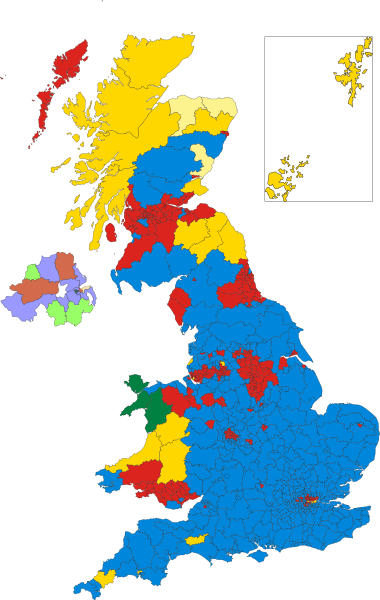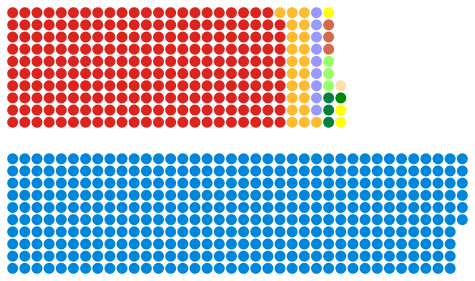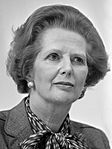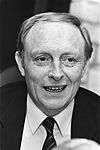1987 United Kingdom general election facts for kids
|
|||||||||||||||||||||||||||||||||||||||||||||
|
|
|||||||||||||||||||||||||||||||||||||||||||||
|
All 650 seats in the House of Commons 326 seats needed for a majority |
|||||||||||||||||||||||||||||||||||||||||||||
|---|---|---|---|---|---|---|---|---|---|---|---|---|---|---|---|---|---|---|---|---|---|---|---|---|---|---|---|---|---|---|---|---|---|---|---|---|---|---|---|---|---|---|---|---|---|
| Opinion polls | |||||||||||||||||||||||||||||||||||||||||||||
| Turnout | 75.3%, |
||||||||||||||||||||||||||||||||||||||||||||
|
|||||||||||||||||||||||||||||||||||||||||||||

Colours denote the winning party—as shown in 1987 United Kingdom general election § Notes
|
|||||||||||||||||||||||||||||||||||||||||||||

Composition of the House of Commons after the election
|
|||||||||||||||||||||||||||||||||||||||||||||
|
|||||||||||||||||||||||||||||||||||||||||||||
A general election happened in the United Kingdom on June 11, 1987. People voted to choose all 650 members of the House of Commons. The Conservative Party won the election. Margaret Thatcher stayed as Prime Minister for the third time in a row. The Labour Party gained 20 more seats than in the last election, mostly from the Conservatives.
Contents
What is a General Election?
A general election is when people in a country vote for who they want to represent them in the government. In the UK, this means choosing members for the House of Commons. These members are called MPs. The party that wins the most seats usually forms the government. Their leader becomes the Prime Minister.
Why Do Elections Happen?
Elections are important because they let citizens have a say in how their country is run. They can choose leaders who they believe will make the best decisions. This is a key part of democracy.
Main Political Parties
In the 1987 election, three main groups were competing. These were the Conservative Party, the Labour Party, and the SDP–Liberal Alliance.
The Conservative Party
The Conservative Party was led by Margaret Thatcher. She had been Prime Minister since 1979. The Conservatives believed in less government control over businesses and more individual freedom. They wanted to make the economy stronger.
Margaret Thatcher's Role
Margaret Thatcher was a very strong leader. She was often called the "Iron Lady." She had won the previous two elections in 1979 and 1983. Many people supported her policies.
The Labour Party
The Labour Party was led by Neil Kinnock. This party usually supports workers' rights and public services like healthcare and education. They wanted to reduce unemployment and help people who were struggling.
Labour's Goals
Labour aimed to improve public services and create more jobs. They wanted to change some of the Conservative government's policies. They hoped to win back voters who had supported the Conservatives.
The SDP–Liberal Alliance
This was a group made up of two parties: the Social Democratic Party (SDP) and the Liberal Party. They were led by David Steel (Liberal) and David Owen (SDP). They offered a middle ground between the Conservatives and Labour.
Alliance's Aims
The Alliance wanted to reform the voting system. They also focused on environmental issues and social justice. They hoped to break the two-party system in British politics.
Election Results
The election took place on June 11, 1987. Millions of people across the UK voted. The results showed a clear winner.
How Many Seats Each Party Won
- Conservative Party: 376 seats
- Labour Party: 229 seats
- SDP–Liberal Alliance: 22 seats
The Conservatives won the most seats, even though they won fewer seats than in the 1983 election. They still had a large majority. This meant they had more than half of all the seats in the House of Commons.
What the Results Meant
The Conservative Party's win meant Margaret Thatcher continued as Prime Minister. It was her third election victory. The Labour Party gained some seats, showing they were becoming stronger. The SDP–Liberal Alliance lost one seat.
Voter Turnout
About 75.3% of people who could vote actually did. This was a bit higher than the previous election. It shows that many people cared about the outcome.
After the Election
After the election, Margaret Thatcher formed her new government. She continued with her policies. The Labour Party became the main opposition party. They worked to challenge the government's decisions.
Impact on British Politics
The 1987 election confirmed the Conservative Party's strong position. It also showed that the Labour Party was starting to recover after a difficult period. The SDP–Liberal Alliance struggled to make a big impact.
See also
 In Spanish: Elecciones generales del Reino Unido de 1987 para niños
In Spanish: Elecciones generales del Reino Unido de 1987 para niños



